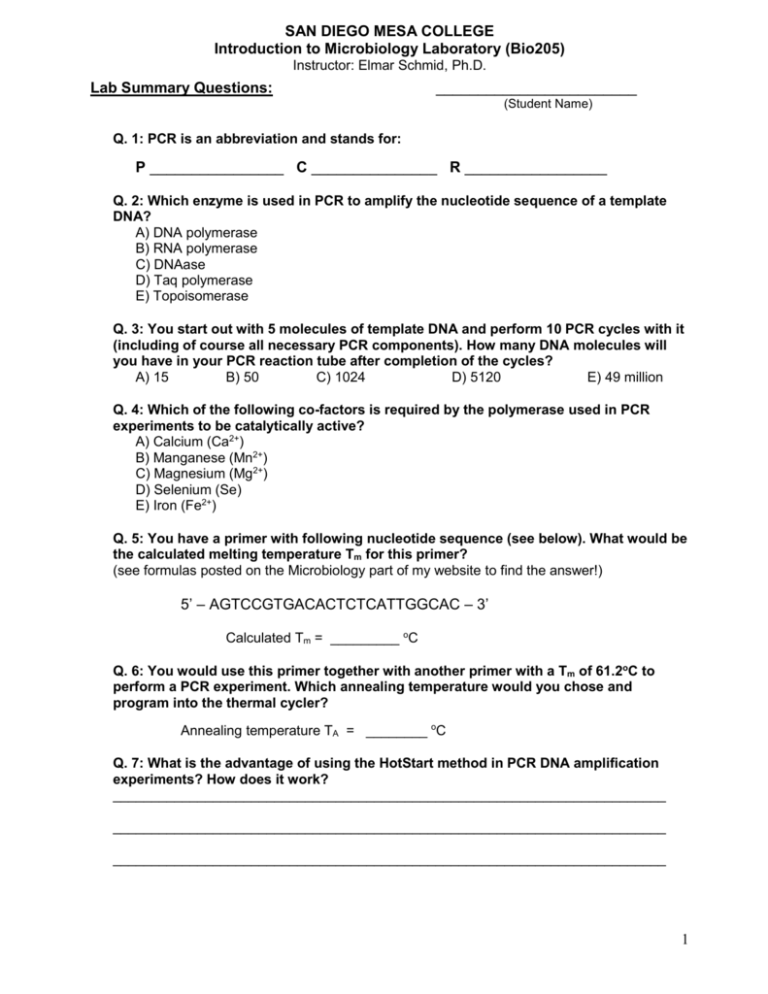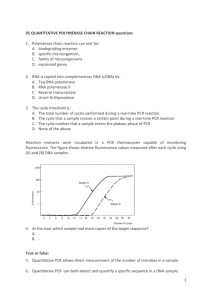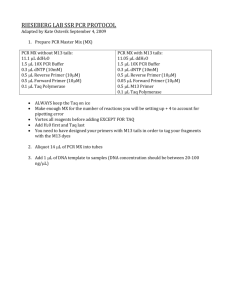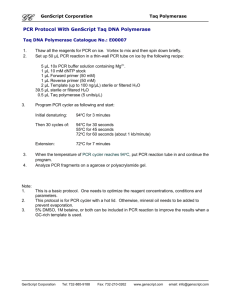PCR amplification of the bacterial genes coding for nucleic acid
advertisement

SAN DIEGO MESA COLLEGE Introduction to Microbiology Laboratory (Bio205) Instructor: Elmar Schmid, Ph.D. Lab Summary Questions: ________________________ (Student Name) Q. 1: PCR is an abbreviation and stands for: P ________________ C _______________ R _________________ Q. 2: Which enzyme is used in PCR to amplify the nucleotide sequence of a template DNA? A) DNA polymerase B) RNA polymerase C) DNAase D) Taq polymerase E) Topoisomerase Q. 3: You start out with 5 molecules of template DNA and perform 10 PCR cycles with it (including of course all necessary PCR components). How many DNA molecules will you have in your PCR reaction tube after completion of the cycles? A) 15 B) 50 C) 1024 D) 5120 E) 49 million Q. 4: Which of the following co-factors is required by the polymerase used in PCR experiments to be catalytically active? A) Calcium (Ca2+) B) Manganese (Mn2+) C) Magnesium (Mg2+) D) Selenium (Se) E) Iron (Fe2+) Q. 5: You have a primer with following nucleotide sequence (see below). What would be the calculated melting temperature Tm for this primer? (see formulas posted on the Microbiology part of my website to find the answer!) 5’ – AGTCCGTGACACTCTCATTGGCAC – 3’ Calculated Tm = _________ oC Q. 6: You would use this primer together with another primer with a Tm of 61.2oC to perform a PCR experiment. Which annealing temperature would you chose and program into the thermal cycler? Annealing temperature TA = ________ oC Q. 7: What is the advantage of using the HotStart method in PCR DNA amplification experiments? How does it work? ________________________________________________________________________ ________________________________________________________________________ ________________________________________________________________________ 1 SAN DIEGO MESA COLLEGE Introduction to Microbiology Laboratory (Bio205) Instructor: Elmar Schmid, Ph.D. Q. 8: Which of the following components and/or molecules are embedded into the Ready-To-Go PCR beads you used in this PCR lab and do NOT have to be added to the PCR reaction mixes? (Make check marks to indicate the presence in the beads) Ο Ο Ο Ο Ο Ο Ο Distilled, DNAse-free water Taq polymerase forward and reverse primer Tris buffer Magnesium chloride (1.5mM) Non-ionic detergent, e.g. Tween-20 Nucleotides (dNTPs) Q. 9: For which of the following genes and/or genomic sequences would you expect to see PCR amplification products even with a small amount of template DNA as 0.5ng after 30 cycles? A) Actin gene B) Hexokinase gene C) 16S rRNA gene D) SINE/Alu sequences E) both c and d Q. 10: What function has the overlay of PCR reaction mixes with mineral oil (in older thermal cyclers) or the heated lid in newer generations of thermal cyclers? _________________________________________________________________________ _________________________________________________________________________ 2









